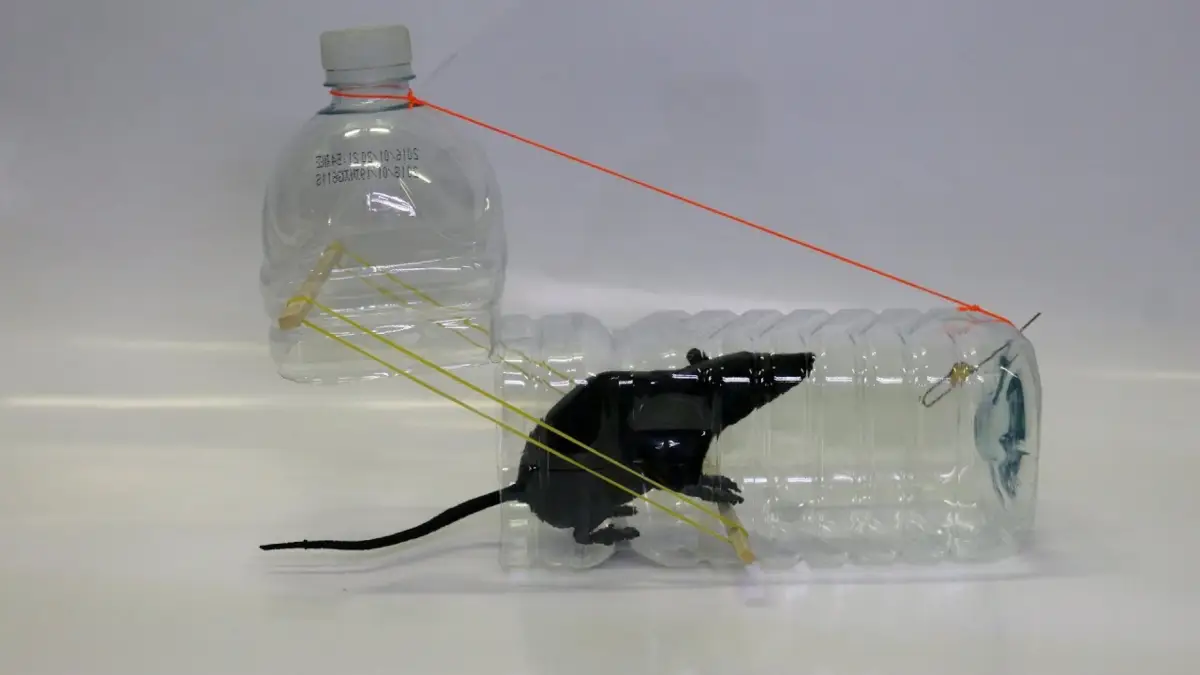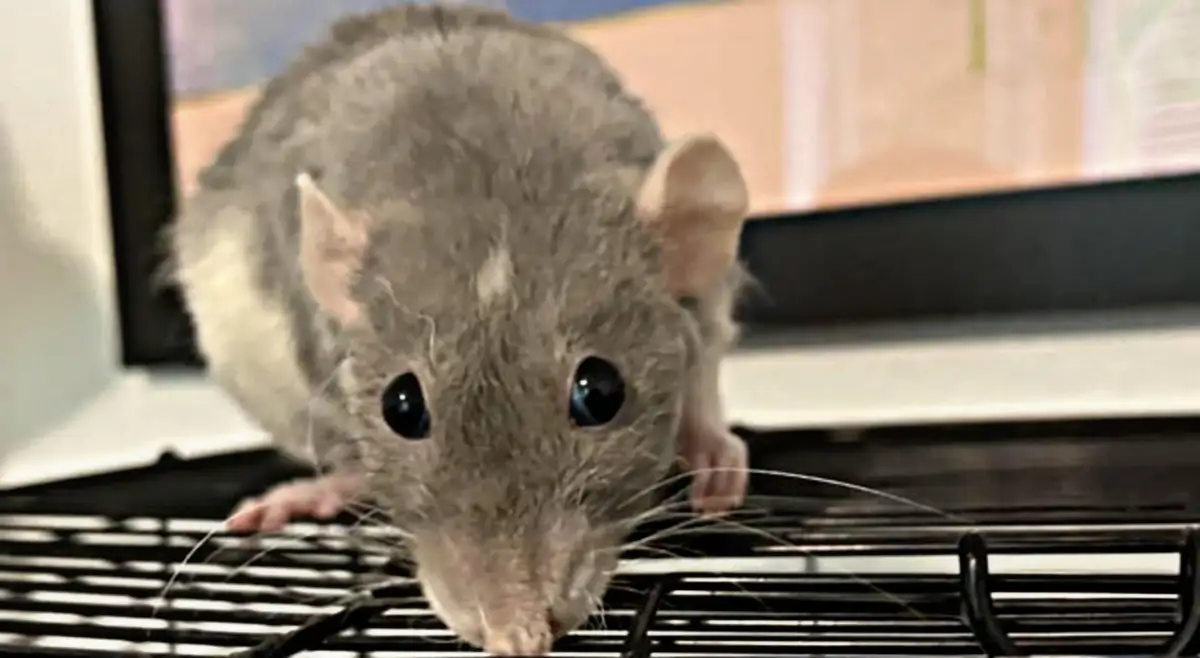Mouse traps can cost a lot, especially if you have many mice to get rid of. But don’t worry – you can make a homemade mouse trap that kills, cheap and effective using things you already have at home. Just grab some cardboard rolls, plastic bottles, or coffee cans, and you’re good to go.
Shawn Woods shares a video tutorial on how to catch mice with the cowboy coffee can mouse trap.
How to Make a Homemade Mouse Trap that Kills Using Coffee Can

1. Get a Big Coffe Can
You need a big coffee can that is around 5 to 6 inches wide and 7 to 8 inches tall. Make sure the can has smooth sides, so mice can’t climb it easily.
If you have a super deep coffee can, around 10 inches or more, put a small pad or some cloth at the bottom to keep the mice safe when caught.
You can use either plastic or metal coffee cans. But if you choose metal cans, make sure they don’t have ribbed rings that mice could climb and escape from.
2. Use Construction Paper on the Can Top
Cover the can top with construction paper and keep it in place using a rubber band around the rim. Use an extendable blade to cut an “X” shape on the paper’s top, stopping about an inch from the edge at each line.
You can use tissue paper instead of construction paper. Make sure the covered coffee can looks sturdy enough for the mouse to walk on it. Instead of cutting a solid “X,” try poking small, closely-spaced holes in the shape of an “X” on the paper’s surface.
3. Put the Can on the Floor Where the Mouse Usually Hangs Out
Take a long ruler or a paint stirring stick and place it from the floor to the opening of the coffee can. If needed, use tape to secure the ruler or stick to the can.
Mice can be of different sizes. If you notice that your mice can’t climb up the thin ruler, try using two rulers placed side by side and taped together to make it easier for them to get to the mouse trap.
4. Bait the Trap
Put some food, like cheese, candy, or bread, on the construction paper. Place the food near the edge of the coffee can, directly opposite the point where the ruler or stick meets the can’s mouth. This will attract the mouse to the trap.
Choose a bait that is not too heavy and won’t make the covered surface of the coffee can look unstable. Also, avoid placing the coffee can near a countertop or step stool where the bait could be eaten from the far side of the ramp without crossing over the construction paper.
5. Wait for the Mouse to Fall into the Trap
The mouse will climb up the ruler to reach the food on the other side of the coffee can. When the seemingly solid surface gives way, it will fall into the can.
You will know the trap worked if the bait is gone, or if you see the construction paper is partly torn. Check the can to see if the mouse is inside.
Take away the ruler or makeshift ramp from the can. Carry the can to a spot around 5 to 10 miles away from where people live. Put the can on the ground and turn it sideways to let the mouse get out safely. If your goal is to make a homemade mouse trap that kills, then you have to serve poisoned bait. But consider giving the critter a second chance.
How to Make a Homemade Mouse Trap that Kills Using a Plastic Bottle

1. Get a 1-liter Plastic Water Bottle
Get a one-liter plastic water bottle or a similar size bottle, ideally long and narrow with flat sides to sit undisturbed. You can also use a two-liter bottle. Just make sure it’s transparent and made of thin, pliable plastic.
2. Cut a 1-inch Horizontal Line Around the Bottle
Using a scalpel or extendable blade, cut a one-inch horizontal line around the bottle. Start where it begins to taper toward the cap. Remember not to cut the top completely off; instead, cut about 90% of the way around the bottle. Once you’re done cutting, the bottle’s “hinge” (the 10% portion you left uncut) should be flexible.
3. Place the Bottle on the Table with the Hinge Facing Down
Use a black marker to mark two points on each side of the bottle, about one centimeter away from the cut, and half a centimeter from the top edge. Make sure the marks are symmetrical on both sides.
If your bottle is round instead of having flat sides, it can be trickier to figure out where to place the marks. Try to put the marks about 90 degrees apart from each other around the bottle’s circumference – two on one side of the cut and two on the opposite side.
4. Bait with Cheese
Take two five-inch wooden skewers, like the ones used for grilling shish kebabs or crafting projects. Make sure they are thin, about a millimeter in diameter. Insert the skewers through the bottle from one set of marks to the other, following the points you marked earlier.
The skewers should go through the bottle in two straight lines that run across it, like a cross. Now, put a third skewer, half the length of the first two, into the bottom of the bottle. Attach a piece of cheese to the end of this skewer inside the bottle. Then again, cheese can be pungent, and unappealing to mice. If you use strong-smelling cheeses as mice lure, it would likely drive them away from the homemade trap. If you are looking to make a homemade mouse trap that kills, you have to poison the bait.
5. Attach a String to the Bottle
Now, with the bottle’s hinge on the table, you should have two skewers through the top part (one on each side of the cut).
Flip the bottle over so that the hinge is on top. Unscrew the cap and insert a string, about as long as the bottle, through the mouth, leaving about an inch inside. Tighten the cap back on securely while the string is partly inside. Give the string a gentle tug to make sure it sits snugly under the bottle cap.
6. Wrap the Skewer with Rubber Bands
Wrap rubber bands, approximately one centimeter in diameter, around the skewers. If you can’t find bands that size, elastic hair ties can work too. Put one band around the two skewers on the left side of the bottle and another band around the skewers on the right side, keeping the hinge on the upper side of the bottle.
When you lift the cap of the bottle while it’s lying on its side with the hinge above the skewers, the bands should provide some resistance. Now, tie the other end of the string in a loop around the skewer that sticks out from the far end.
7. Place the Homemade Mouse Trap Where the Critter Frequents
Put the trap in a spot where mice are likely to go, such as near a wall or a busy area close to a mouse hole. When the mouse goes into the bottle to eat the cheese, pull the string looped around the skewer at the bottom. The bottle will quickly close, trapping the mouse inside.
Place the trap where mice are likely to go, like near a wall or a busy area close to a mouse hole. When the mouse enters the bottle to eat the cheese, pull the string looped around the bottom skewer. The bottle will snap shut, trapping the mouse inside.
8. Dispose of Any Caught Mouse
Carry the bottle with the trapped mouse away from your home, wearing sanitary gloves. Go at least 5 to 10 miles away from any houses. Release the mouse in a meadow or forest by opening the trap. Afterward, throw away the sanitary gloves and the bottle trap.
This trap is excellent for catching smart mice roaming freely around your house. If the mice are used to being around people and boldly run around even when many people are present, you can easily catch them with this trap.
Need a video guide? Here’s Zaman’s water plastic bottle mouse trap that works.
How to Make a Homemade Mouse Trap that Kills Using Cardboard Rolls

1. Prepare a Cardboard Tube
Get a long cardboard tube that’s closed at one end, like a paper towel roll or a poster tube. Make sure it’s at least 12 inches long and has a mouth diameter of 2-5 inches. Seal the closed end with tape or a cap.
Now, stuff something soft like cotton balls or a wad of soft fabric inside the closed end.
2. Flatten the tube by pressing one edge
To prevent it from rolling, create a flat side. Make a long crease along its length, then another one about 40 degrees away from the first one. Use a ruler inside the tube to flatten the space between the creases.
3. Bait the Cardboard Tube
Put some cheese, candy, or bread at the far end of the tube to attract the mouse. Make sure it’s not too heavy to change the tube’s weight significantly.
Avoid sticky or gummy foods as they might get stuck inside the tube. If you prefer using something like peanut butter, you can apply it to the bait end before putting the cap on.
4. Put the Tube on the Edge of a Countertop or Second-story Landing
Make sure about 40% of the tube, including the baited end, hangs over the edge. You can use a small piece of tape to secure it if needed but don’t tape it too tightly so it can’t tip over the edge when the baited end is slightly pushed.
If you have a single-story home, get a cardboard box about one foot high. Create a cardboard ramp leading up to the top of the box. Place one end of the tube at the end of the box.
5. Put a Trash Can Under the Tube
Make sure the can is wide enough to catch the falling tube. Place a small pillow, soft cloth, or pad inside the can to cushion the tube and the mouse that will soon be trapped inside.
Avoid using a too-wide trash can because the tube might end up resting at an angle instead of straight up and down. If that happens, the mouse could easily climb out of the tube.
6. Check the Trap Often
If you see the tube sticking up from the trash can, it means the trap is set. Look down the tube to see if the mouse is inside. Carefully remove the tube, keep the open end up, and take it at least 5 to 10 miles away from your home. A preferable place is where there are no houses. Gently release the mouse in a field or meadow.
This trap works well, especially for mice on the second story or those with access to it. If you don’t want to drop the tube into a garbage pail below the upper-story landing, you can attach the entire tube with a piece of string to the landing. So, when the mouse triggers the trap, the tube won’t fall into the garbage pail but will dangle safely from the ledge until you retrieve it.
Lifehacker shares a video guide you can follow to use your cardboard paper to trap mice in your home.
- The Cheesy Truth About Rodent Bait. Victor Pest
- What Attracts Mice to Your House? TomCat Brand
- How to Trap Up to Remove a Rodent Infestation. Center for Disease Control and Prevention (CDC)
Read also: Best mouse trap for home with pets






